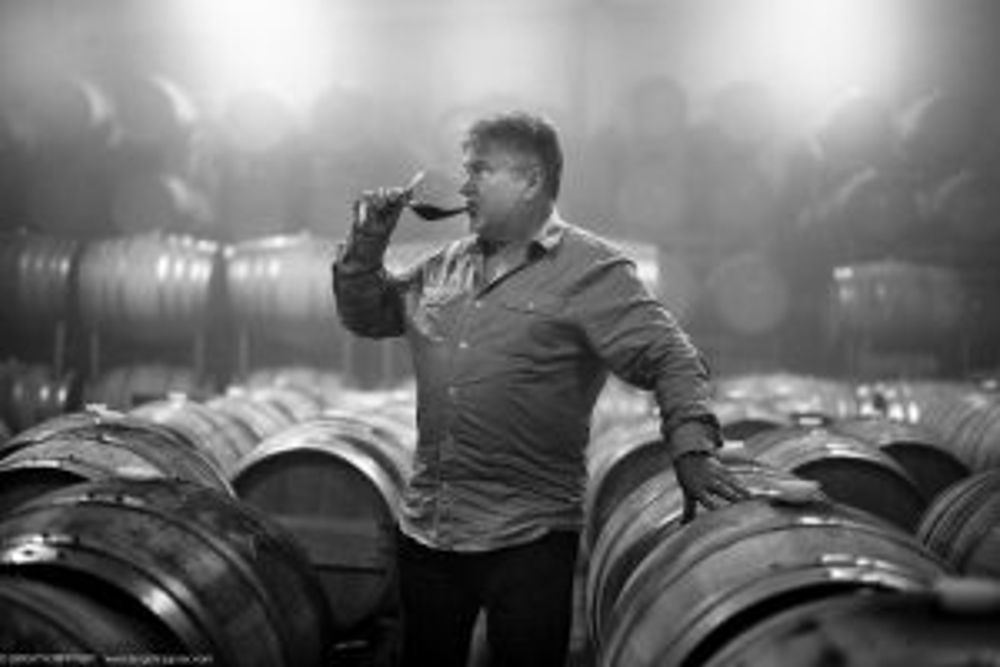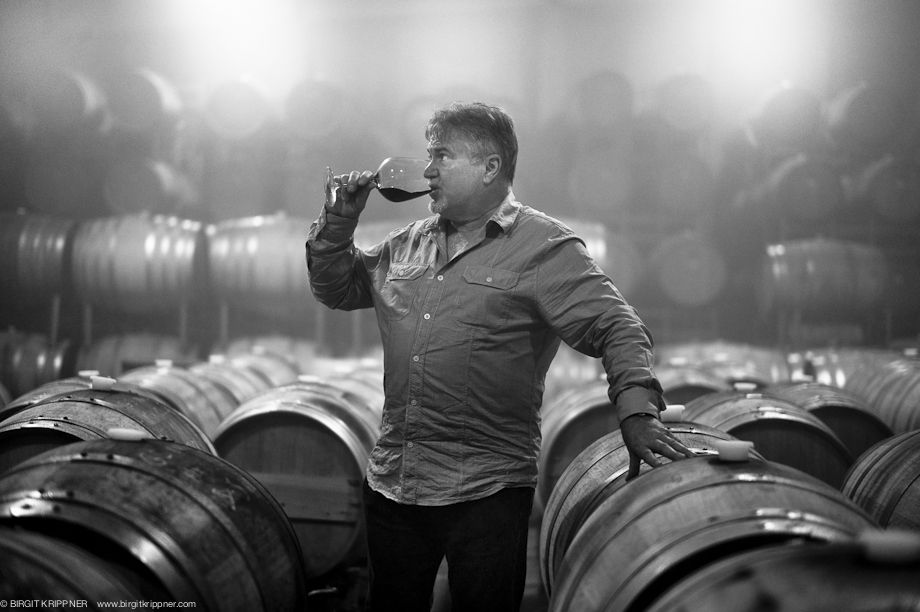Much ado about nothing? We don’t think so as the evidence that Hawke’s Bay Syrah can provide an exciting array of distinct styles is there to see and taste in the glass.
New Zealand is just one wine-producing country on a global trend – and no, the trend is not a new grape variety or even a wine style, the trend is one of ever closer mapping, ever greater scrutiny of soils and sites, ever more distinct sub-regionalisation and, in that very process, a deep engagement with and profound exploration of agricultural land.
John Hancock, owner and winemaker at Trinity Hill and Steve Skinner, head winemaker at Elephant Hill, both of Hawke’s Bay in New Zealand’s North Island, were in London to give a masterclass on Syrah, the prism through which they explored their own zone’s sub-regionality and its “ability to produce world class Syrah.”

A very ebullient Hancock framed the debate early on when he put Syrah plantings in context. He first outlined the very recent history of Syrah in New Zealand. It did not start until the mid 1980s when Dr Alan Limmer rescued some 20 Syrah vines from a grape research centre in the Waikato as they were shutting down their nursery operation. Apparently these Syrah vines could be traced back to the vines brought over by New Zealand governor general James Busby (of Australian wine fame) in the 19th century from the Rhône.
“Almost all of the Syrah plantings in New Zealand came from these 20 vines he rescued,” Hancock says.
Limmer planted the first Syrah in Hawke’s Bay and released his first wine in 1986. By then, the Gimblett Gravels had been recognised as prime vineyard land but planting, almost inevitably perhaps, focussed on Cabernet Sauvignon and Merlot, something still reflected in the plantings today.
But Hancock is clear: “Syrah is a little like Pinot Noir, it’s very transparent, it shows very much where it comes from. That’s why I think Syrah will be the variety that Hawke’s Bay makes its name with, because these Syrahs are distinct: that spicy, meaty, savoury kind of Syrah. It’s distinctly Hawke’s Bay.” But he put it into context quickly: “Having said that, Syrah only represents 4% of Hawke’s Bay’s production and only 1% of all New Zealand production. So some might say this a lot of noise about nothing.”

Elephant Hill winemaker Steve Skinner
Steve Skinner added that the small number had remained static for a long time: “There hasn’t been a great deal of planting between the financial crisis and now.”
Indeed, Merlot and Cabernet represent 25% of plantings, Sauvignon Blanc 28%, Chardonnay 21%, Pinot Gris 12%, Pinot Noir 7%, Syrah just 4% while the remaining 3% are a mix of varieties. Astonishingly, at least for us in the UK, 63% of Hawke’s Bay’s total production is white wine – when we know it as a premium region for reds.
Hancock and Skinner then showed us a zoned map of Hawke’s Bay, formed by the five main rivers of the region, depositing gravels and shifting the alluvial plains. The sub-regions are Esk River, Te Awanga, Heretaunga, Bridge Pa, Gimblett Gravels, Ohiti, Dartmoor, Mangatahi & Crownthorpe, Havelock Hills, Tukituki and Central Hawke’s Bay. Their differences are down to soil, how much clay is in the gravel and alluvial mix, their altitude and how close they are to the ocean.
The wines Skinner and Hancock had brought with them were mainly from the Gimblett Gravels, from Bridge Pa and Te Awanga. Skinner explained that Te Awanga “is considerably cooler, always influenced by sea breeze. Syrah there is planted on heavy clay and has a very different profile. In Te Awanga you cannot ripen Cabernet Sauvignon.” Hancock adds that “Gimblett Gravels is an old riverbed, probably the youngest vineyard soil in the wold, still forming, these soils have very little organic matter, we add compost” while “Bridge Pa, currently dominated by Merlot, has the same structure underneath with deposits of loam as top soil.” The different soils structures also mean that gravelly areas need irrigation while areas like Te Awanga can be dry-farmed.”

John Hancock and Steve Skinner from Trinity Hill and Elephant Hill (l-r), London October 2017
Skinner and Hancock made clear that vintage variation played a vast role and that climate change “was the elephant in the room. It’s definitely getting warner,” Hancock says, “But not necessarily drier,” adds Skinner: “We are concerned with irrigation – better irrigation and less irrigation.”
Nonetheless, across these areas, Hancock asserted, “Syrah is the style we can make our own.” Indeed, the wines certainly covered the full spectrum of Syrah: from fragrant, delicately red-fruited and peppery all the way to muscular, spice-tinged and full-bodied.
They also spoke of the way Syrah was being vinified: “What is starting to happen is the use of older and larger oak – we are certainly much more interested in what the vineyard has to say – we are not applying too much make-up,” Hancock says. “We’re starting to see a fair amount of whole bunch. I guess we are looking for another dimension – not just that berry, some of that spice.”
Skinner added: “We have done everything from zero to 100% of whole bunch. Depending on the clone this brings out clove and nutmeg notes and we find that a really interesting blending component.” They also expanded on the use of Viognier in co-fermentation and on no longer aiming for sheer power but for elegance. The wines they showed were very fresh. Hancock confirms: “We certainly don’t have a problem with acid in Hawke’s Bay. All acid is natural. Real acidity is one of the hallmarks of Hawke’s Bay Syrah.”
Clearly the question is whether anyone will grub up Cabernet Sauvignon and Merlot in order to plant more Syrah, whether grafting over is possible and whether new plantings in the area will be predominantly of Syrah. Sub-zoning and increasing understanding of sites helps these winemakers to produce ever more unique Syrah styles, despite their limited plantings – and they are clearly on to something. “Within Hawke’s Bay we believe strongly in Syrah and that we can make it our own,” Hancock says.

Trinity Hill owner and winemaker John Hancock
But like any sentient and sensible human confronted with the complex make-up of nature – especially one as gorgeous as New Zealand – he is humble: “It’s still early days for us in Syrah-making, we are still finding our way. We’ve hardly scratched the surface yet of regional styles. We see Syrah as the future; we are just trying to keep pushing things slowly to build a nice solid base.” Hurrah to that because we, the drinkers, are the biggest winners in this welcome, necessary and positive trend of profound understanding of land.
The wines shown, listed here not in their tasting order but according to sub-region, represent top wines made in small quantities. All of them had elegance and indeed showed a spectrum of styles – but all at a very high level of quality – often for great value prices.
“In terms of vine age,” Hancock said “the best is yet to come.”
The Hawke’s Bay Syrah shown at the London masterclass
Bridge Pa – which shows plump, rounded, almost voluptuous fruit
- Babich Winemakers Reserve Syrah 2014 – lovely purity, elegance and Morello cherry sumptuousness
- Paritua Syrah 2014 – sprays of fresh white pepper amidst velvety folds of cherry
- Craft Farm Syrah 2015 – wonderfully evocative and elegant, both fragrant and vivid
- Te Mata Bullnose Syrah 2015 – a big, bold wine but very elegantly understated. One to keep and wait for.
Gimblett Gravels – which has more pronounced structure
- Craggy Range Le Sol Syrah 2015 – sumptuous, floral with dense but fine tannins
- William Murdoch Coldstream Syrah 2012 –from a cooler year this was still overwhelmed by oak
- Vidal Estate Legacy Syrah 2014 – brilliant fruit and bright acidity counter the mouth-coating tannins, another one for the cellar
- Trinity Hill Homage 2014 –tannic frame interwoven with aromatic charm of violet and mulberry
- Elephant Hill Airavata 2014 – 1/3 of fruit from cooler Te Awanga – still evolving and softening its big, bold structure
Havelock Hills and Maraekakaho – cooler sub-region with friable clay soils
- Rod McDonald Quarter Acre Syrah 2015 – very fresh, super-spicy and utterly charming, almost poetic style
































